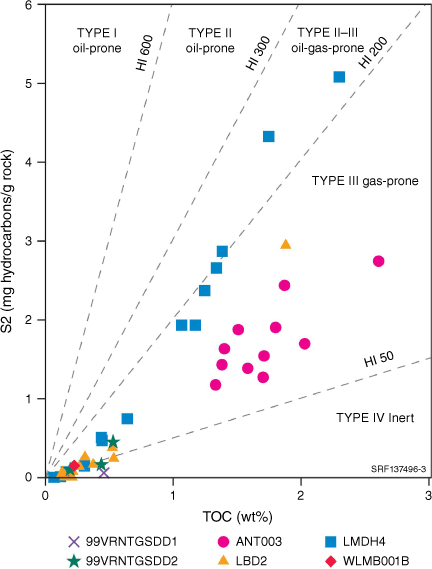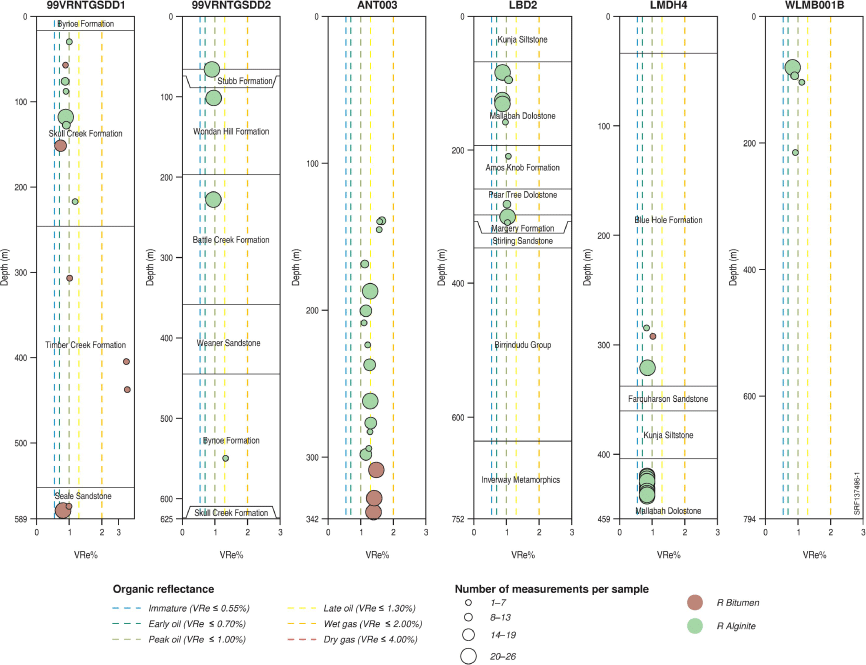Source rocks of the Birrindudu Basin: perspectives from a new sampling program
Grace A. Butcher A * , Emmanuelle Grosjean A , Tehani J. Palu A , Padmasiri Ranasinghe B , Richard H. Kempton C and Siyumini Perera CA
B
C

Grace A. Butcher is a geologist at Geoscience Australia working in the Minerals, Energy and Groundwater Division. She graduated with a BSc (Hons) in 2010 from the School of Earth and Environment at the University of Leeds. Grace is working on northern Australian basins as part of the Exploring for the Future Program. |

Emmanuelle Grosjean is an organic geochemist at Geoscience Australia working in the Minerals, Energy and Groundwater Division. Emmanuelle applies organic geochemistry to assess the hydrocarbon prospectivity of Australia’s offshore and onshore sedimentary basins. Emmanuelle holds a doctorate degree in organic chemistry from the University of Strasbourg, France. |

Tehani J. Palu holds a Master’s in Earth Science with first-class honours from the University of Waikato, New Zealand, and has been with Geoscience Australia since 2009. Tehani has been a petroleum systems analyst in the Onshore Energy Systems team since 2014 after working on several other related projects including carbon capture and storage monitoring and offshore acreage release. |

Padmasiri Ranasinghe has over 45 years of expertise in geology, botany and computer science. He specialises in analysing petroleum source rocks. He has produced numerous consultancy reports, provided training in organic petrology, and actively contributes to industry standards through participation in International Committee for Coal and Organic Petrology working groups. |

Richard H. Kempton obtained a BSc (Hons) in geology from the University of Melbourne (1992) and a PhD in geology from the University of Western Australia (2000). Richard is a senior research scientist with the Geofluids Team at CSIRO Energy in Perth and has 20+ years’ experience in petroleum systems analysis using fluid inclusions to reconstruct charge histories. Prior to joining CSIRO, Richard worked for the Queensland Gas Company. He is a member of PESA and GSA. |

Siyumini Perera recently obtained her PhD from the University of Queensland, where she focussed on Early Paleozoic biostratigraphy and imaging of microfossils with micro-computed tomography. Since early 2023, she has joined the Geofluids Team at CSIRO Energy in Perth as a research technician and is undertaking fluid inclusion analyses to quantify and characterise geofluids within sedimentary basins and basement. |
Abstract
The Paleo- to Mesoproterozoic Birrindudu Basin is an underexplored frontier basin straddling the Northern Territory and Western Australia, and is a region of focus for the second phase of Geoscience Australia’s Exploring for the Future (EFTF) program (2020–2024). Hydrocarbon exploration in the Birrindudu Basin has been limited and a thorough assessment of the basin’s petroleum potential is lacking due to the absence of data in the region. To bridge this data gap, a comprehensive analytical program including organic petrology, programmed pyrolysis and oil fluid inclusion analysis was undertaken on cores from six drill holes to improve the understanding of the basin’s source rock potential and assess petroleum migration. Organic petrological analyses reveal that the primary maceral identified in the cores is alginite mainly originating from filamentous cyanobacteria, while bitumen is the most common unstructured secondary organic matter. New reflectance data based on alginite and bitumen reflectance indicate the sampled sections have reached a thermal maturity suitable for hydrocarbon generation. Oil inclusion analyses provide evidence for oil generation and migration, and hence elements of a petroleum system are present in the basin.
Keywords: Birrindudu Basin, Exploring for the Future, oil inclusions, oil migration, organic petrology, petroleum potential, Proterozoic, source rocks, thermal maturity.
Introduction
The Paleo- to Mesoproterozoic Birrindudu Basin is an underexplored frontier basin located in northwestern Northern Territory and northeastern Western Australia (Dunster and Ahmad 2013) (Fig. 1), which was selected as a focus region for the second phase of the EFTF program (2020–2024) to understand the basin’s resource potential. The Birrindudu Basin contains strata of similar age to the prospective McArthur Basin, South Nicholson region and Mount Isa Province to the east, but remains comparatively poorly understood due to the lack of data (Korsch 2024). Hydrocarbon exploration in the Birrindudu Basin has been limited, despite the existence of petroleum systems in correlative units within the adjacent McArthur Basin (Jarrett et al. 2021). Understanding the petroleum potential of the basin has been hampered by the scarcity of source rock data and, in particular, the lack of organic petrology maturity data (Korsch 2024).
Regional geological map showing the provisional Birrindudu Basin outline (dashed), drill holes for selected analyses and seismic survey lines.

Geoscience Australia, in collaboration with the Northern Territory Geological Survey (NTGS), has acquired new 2D deep crustal seismic data to fill critical gaps in knowledge on the stratigraphy, architecture and resource potential of the basin (Henson et al. 2024). Furthermore, multiple analytical datasets on samples collected from selected drill holes in the basin were acquired (Fig. 1), including organic geochemistry, organic petrology and oil inclusion studies, to provide new insights into the petroleum system elements of the Birrindudu Basin.
Samples and methods
Drill core samples were collected from the NTGS Darwin core repository in 2022 from drill holes 99VRNTGSDD1, 99VRNTGSDD2, ANT003, LBD2, LMDH4, WLMB001B (Fig. 1). The stratigraphy is documented for 99VRNTGSDD1, 99VRNTGSDD2 and LBD2 in well completion reports (Fig. 2). The stratigraphy for LMDH4 is reported in Munson (2023) and reproduced in Fig. 2, but stratigraphic information is not available for WLMB001B and ANT003. Organic petrological analyses were undertaken on 130 samples from these six wells to determine the organic matter type and thermal maturity of the rocks (Ranasinghe and Crosdale 2023). These data are complemented by programmed pyrolysis on 178 samples to assess the hydrocarbon-generating potential of sampled cores using a Rock-Eval 6 instrument (Butcher et al. 2023). Rock-Eval pyrolysis data on these newly collected samples were checked for quality using methods described in Grosjean et al. (2023). In addition, a total of 45 thin sections from 3 drill holes (Fig. 1) were analysed by the grains with oil inclusions (GOI™) and frequency of oil inclusions (FOI™) methods to provide insights into the oil charge history of the basin (Kempton and Perera 2023).
Thermal maturity data
Organic petrological analyses identified that fluorescing alginite shaped as elongated filaments is the main maceral type while bitumen is the most common unstructured secondary organic matter. The reflectance of alginite (R Alginite, Faiz et al. 2022) and bitumen (R Bitumen, Luo et al. 2021) was used to assess the thermal maturity of the rocks by converting to a vitrinite reflectance equivalent (VRe) value using the following equations:
and
Results indicate that the sampled drill hole sections are all thermally mature for hydrocarbon generation. Drill holes 99VRNTGSDD2 and ANT003 are within the peak oil zone window at the top of the drill hole and overmature for oil generation at the base having reached a wet gas maturity (1.3 < VRe < 2%) (Fig. 2). The sampled sections in WLMB001B, 99VRNTGSDD1, LBD2 and LMDH4 are mostly within the oil window (Fig. 2). Reflectance measurements in the drill hole WLMB001B were only acquired for the top section because rocks below 240 m in WLMB001B are barren of organic matter.
Source rock potential
The hydrocarbon-generating potential of the newly collected rocks was evaluated using organic petrological and programmed pyrolysis data. The predominant organic maceral is alginite which reaches up to 2.8% of the dispersed organic matter by volume (Ranasinghe and Crosdale 2023). Alginite, which belongs to the liptinite maceral group, is chemically aliphatic and considered oil-prone (Pickel et al. 2017). Given that the collected rocks are Paleo- to Mesoproterozoic in age, the maceral alginite in this case is presumably derived from prokaryotic organic matter including filamentous cyanobacteria rather than algae. Inputs from modern eukaryotes, such as algae, were likely negligible at the time (Faiz et al. 2022; Grosjean et al. 2023).
The best hydrocarbon potential in the study area is in the Mallabah Dolostone at LMDH4 showing an alginite-rich zone (0.3–2.7 vol%) that is over 17 m thick (419.58−437.79 m). This is consistent with the Rock-Eval pyrolysis results indicating that the rocks within this interval are organic-rich with a median total organic carbon (TOC) content of 1.3 wt%, maximising at 2.3 wt%. Some rocks within this interval show a Hydrogen Index (HI) value in excess of 200 mg Hydrocarbons (HC)/g TOC and are therefore able to generate liquids (Fig. 3). The Mallabah Dolostone is thermally mature and located within the peak oil generation window (Fig. 2), suggesting that it generated petroleum in the past. This is substantiated by the identification of dead oil, a distinct form of bitumen formed by the solidification of crude oil droplets, detected within the depth range of 419 and 438 m and probably indicating hydrocarbon generation (Ranasinghe and Crosdale 2023). Similarly, potential for hydrocarbon generation was documented in the fluorescing lamalginite and bituminite-rich rock sample of the Pear Tree Dolostone in LBD2 (280.16−280.18 m). A TOC content of 1.9 wt% and HI value of 156 mg HC/g TOC for this sample indicates gas-generating potential (Fig. 3). An organic-rich section in ANT003 from ~307 to 337 m has an average TOC content of 1.7 wt% and HI value of 101 mg HC/g TOC and has reached a wet gas maturity level, which suggests potential for gas generation.
Plot of TOC versus Rock‐Eval parameter S2 (amount of pyrolysable hydrocarbons) for the six wells assessed in this study. HI, Hydrogen Index, defined as HI = S2/TOC x 100.

Approximately half of the sample suite analysed for organic petrology lack any structured organic matter. In particular, a >300 m thick sedimentary package encompassing the Timber Creek Formation and the Seale Sandstone in 99VRNTGSDD1 was devoid of any structured organic matter and similarly, the interval in WLMB001B from 240 m to total depth at 793.6 m, is completely barren of organoclasts.
Evidence for oil migration
Evidence for oil migration in the Birrindudu Basin has been limited to oil shows found in the drill hole 99VRNTGSDD1 (Dunster and Ahmad 2013). This study aimed to assess the oil charge history in the Birrindudu Basin by analysing 45 drill core samples from WLMB001B, ANT003 and 99VRNTGSDD1 for the presence of oil-bearing fluid inclusions using the GOI and FOI methods. These analyses record oil inclusions in WLMB001B and ANT003 (Kempton and Perera 2023).
Elevated FOI results (up to 100%) in WLMB001B are confined to calcite-filled veins between 444 and 521 m. These provide evidence for the migration and entrapment of a medium gravity (<40°API) oil along fracture pathways now cemented by hydrothermal calcite. In ANT003, high FOI values indicating entrapment of a light gravity oil were measured in calcitic dolomicrite samples between 305 and 343 m. It is likely that these light oil inclusions were generated in-situ by the local source rock occurring in this interval because of a lack of migration pathways through the tight microcrystalline rock fabric. In-situ oil generation in this drill hole is also supported by the detection of dead oil at similar depths, i.e. between 308 and 337 m (Ranasinghe and Crosdale 2023).
Live oil bleeds are recorded in the Lower Timber Creek Formation and upper Seale Sandstone in 99VRNTGSDD1 (Dunster and Ahmad 2013), however, evidence for the entrapment of paleo-oil in any of the sandstones or carbonate rocks was not found (i.e. nil GOI and FOI results) in this drill hole. The absence of oil inclusions in the 99VRNTGSDD1 samples tested for this study is probably due to timing differences between migration and the formation of trapping sites.
Conclusions
New geochemical analyses from drill cores 99VRNTGSDD1, 99VRNTGSDD2, ANT003, LBD2, LMDH4, and WLMB001B from the Birrindudu Basin reveal that the sampled sections in these drill holes are thermally mature for hydrocarbon generation. Alginite, likely derived from filamentous cyanobacteria, was the main organic maceral in the samples. Hydrocarbon generating potential is confirmed in several rocks with the best oil potential identified in LMDH4. The occurrence of oil inclusions in WLMB001B and ANT003 indicates that oil was generated and migrated through the basin, demonstrating the presence of elements of a petroleum system.
Data availability
The data that support this study are available in the article and online material accessible via https://www.eftf.ga.gov.au/officer-musgrave-birrindudu.
Acknowledgements
Thanks to Dianne Edwards and Carmine Wainman for their peer review. This paper is published with the permission of the CEO, Geoscience Australia.
References
Butcher G, Grosjean E, Webster T, Jinadasa N, Long I, Williamson A, Boreham C, Carson C (2023) Rock-Eval pyrolysis data from the Birrindudu Basin. Data Release | eCat 148757. Geoscience Australia. 10.26186/148757
Faiz M, Altmann C, Baruch E, Côté A, Gong S, Schinteie R, Ranasinghe P (2022) Organic matter composition and thermal maturity evaluation of Mesoproterozoic source rocks in the Beetaloo Sub-Basin, Australia. Organic Geochemistry 174, 104513.
| Crossref | Google Scholar |
Grosjean E, Jarrett AJM, Boreham CJ, Wang L, Johnson L, Hope JM, Ranasinghe P, Brocks JJ, Bailey AHE, Butcher GA, Carson CJ (2023) Resource potential of the Proterozoic–Paleozoic Carrara depocentre, South Nicholson region, Australia: insights from stratigraphic drilling. Organic Geochemistry 186, 104688.
| Crossref | Google Scholar |
Jarrett AJM, Bailey AHE, Chen J, Munson TJ (2021) Petroleum geology and geochemistry of the Birrindudu Basin, greater McArthur Basin. In ‘Australian Geoscience Exploration Seminar (AGES) Proceedings’, Alice Springs. pp. 115–130. (Northern Territory Geological Survey) https://geoscience.nt.gov.au/gemis/ntgsjspui/handle/1/91413
Kempton RH, Perera S (2023) ‘GOI-FOI palaeo-hydrocarbon assessment of the Birrindudu Basin’. EP2023-5340. (Geoscience Australia: Canberra) 10.26186/149084
Korsch RJ (2024) Basin Inventory: Birrindudu Basin. Record 2023/055. Geoscience Australia, Canberra. https://dx.doi.org/10.26186/148672
Luo Q, Zhang L, Zhong N, Wu J, Goodarzi F, Sanei H, Skovsted CB, Suchý V, Li M, Ye X, Cao W, Liu A, Min X, Pan Y, Yao L, Wu J (2021) Thermal evolution behavior of the organic matter and a ray of light on the origin of vitrinite-like maceral in the Mesoproterozoic and Lower Cambrian black shales: insights from artificial maturation. International Journal of Coal Geology 244, 103813.
| Crossref | Google Scholar |
Munson TJ (2023) ‘Stratigraphic characterisation of the Glyde package, greater McArthur Basin, Northern Territory’. NTGS Record 2023-009. (Northern Territory Geological Survey) https://geoscience.nt.gov.au/gemis/ntgsjspui/handle/1/92765
Pickel W, Kus J, Flores D, Kalaitzidis S, Christanis K, Cardott BJ, Misz-Kennan M, Rodrigues S, Hentschel A, Hamor-Vido M, Crosdale P, Wagner N (2017) Classification of liptinite – ICCP System 1994. International Journal of Coal Geology 169, 40-61.
| Crossref | Google Scholar |
Ranasinghe SP, Crosdale PJ (2023) Source rock type, maturation levels and hydrocarbon potential of a suite of samples from the Birrindudu Basin, Northern Territory, report prepared for Geoscience Australia. 10.26186/148608
 Grace A. Butcher is a geologist at Geoscience Australia working in the Minerals, Energy and Groundwater Division. She graduated with a BSc (Hons) in 2010 from the School of Earth and Environment at the University of Leeds. Grace is working on northern Australian basins as part of the Exploring for the Future Program. |
 Emmanuelle Grosjean is an organic geochemist at Geoscience Australia working in the Minerals, Energy and Groundwater Division. Emmanuelle applies organic geochemistry to assess the hydrocarbon prospectivity of Australia’s offshore and onshore sedimentary basins. Emmanuelle holds a doctorate degree in organic chemistry from the University of Strasbourg, France. |
 Tehani J. Palu holds a Master’s in Earth Science with first-class honours from the University of Waikato, New Zealand, and has been with Geoscience Australia since 2009. Tehani has been a petroleum systems analyst in the Onshore Energy Systems team since 2014 after working on several other related projects including carbon capture and storage monitoring and offshore acreage release. |
 Padmasiri Ranasinghe has over 45 years of expertise in geology, botany and computer science. He specialises in analysing petroleum source rocks. He has produced numerous consultancy reports, provided training in organic petrology, and actively contributes to industry standards through participation in International Committee for Coal and Organic Petrology working groups. |
 Richard H. Kempton obtained a BSc (Hons) in geology from the University of Melbourne (1992) and a PhD in geology from the University of Western Australia (2000). Richard is a senior research scientist with the Geofluids Team at CSIRO Energy in Perth and has 20+ years’ experience in petroleum systems analysis using fluid inclusions to reconstruct charge histories. Prior to joining CSIRO, Richard worked for the Queensland Gas Company. He is a member of PESA and GSA. |
 Siyumini Perera recently obtained her PhD from the University of Queensland, where she focussed on Early Paleozoic biostratigraphy and imaging of microfossils with micro-computed tomography. Since early 2023, she has joined the Geofluids Team at CSIRO Energy in Perth as a research technician and is undertaking fluid inclusion analyses to quantify and characterise geofluids within sedimentary basins and basement. |



